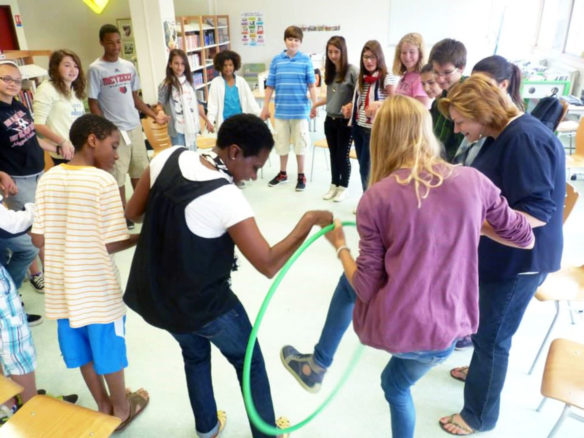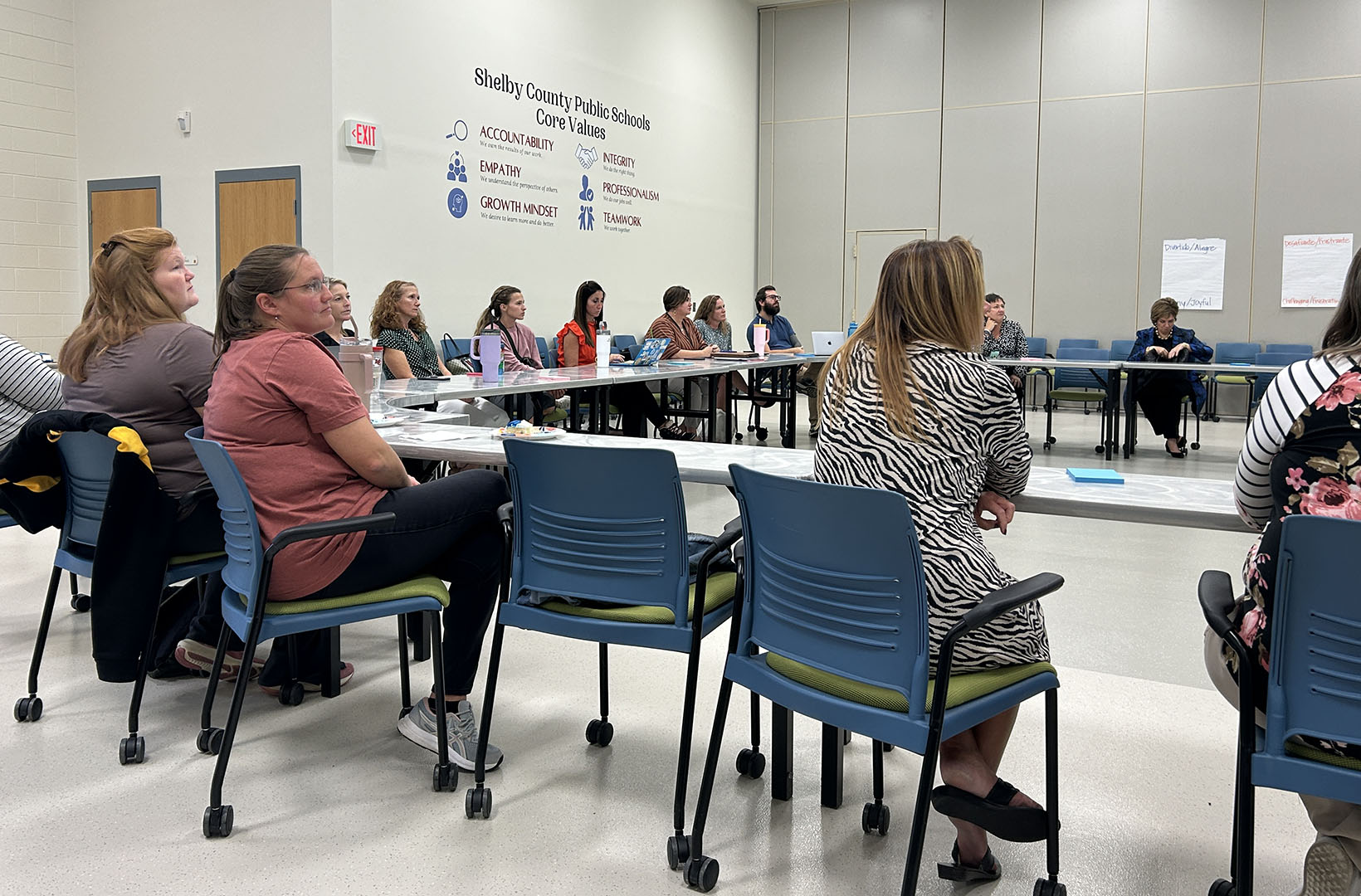
Michele Randolph, center in the black-and-white shirt, a French and Spanish teacher at Meyzeek Middle School (Jefferson County), took her students to France in 2013 to visit students at Collège Louis Pasteur in Montbard, France. Since 2004, Randolph has been partnered with Christine Sobota, a teacher at the French school. This long-lasting partnership has allowed the American and French students pair up each year to learn from each other.
Photo submitted by Michele Randolph
By Michele Randolph
michele.randolph@jefferson.kyschools.us
I teach French and Spanish at Meyzeek Middle School (Jefferson County). In June 2004, under the leadership of Gregory Fulkerson and Jacque Van Houten, I had the privilege of going to Dijon, France, to take part in an International Academy where I met educators from the Burgundy region. At the time, Fulkerson was the world language specialist for Jefferson County and Van Houten was the world language and international education consultant at the Kentucky Department of Education.
By the end of the academy, I was selected to form a partnership with Madame Christine Sobota, a dedicated educator from Collège Louis Pasteur in Montbard, France. Sobota teaches kids who have difficulty learning and she is the documentarist of her school. The purpose of the partnership was to develop authentic communication and to increase cultural acquisition among the groups of students.
We discussed many possibilities, but it became clear that the best way to maximize this newly formed partnership was to facilitate communication between the French and the American students.
Sobota and I made plans for our students to start investigating the cultures as soon as the seminar ended in June 2004. Since the two countries have different back to school dates, we did not start introducing the students to each other until November of that same year.
The two schools always take turn deciding the themes we plan to explore. We have worked on many projects since we have started the partnership and we still work together today. Here are a few of the most memorable things we have done:
- Comparing the nutrition of the meals served to students in the two schools lunchroom
This was one of our first projects. For the occasion, we invited the lunchroom manager of our school to come to class and tell us how our school district chooses each item on the menu for breakfast and lunch. We also had a nutritionist come in and help us analyze how healthy the food we ate at school and outside of school was. The French students did a similar study and then we exchanged information.
- Determining which group of students live a more active life through daily physical activities
This project was so much fun. I asked the district physical education specialist for pedometers that I distributed to the students. I even sent some to the students in France. The two groups registered their steps each day and kept logs of the sports they played and other activities they did to stay healthy. At the end of that study, we shared our findings through a video conference. The students really enjoyed learning about each other’s lifestyle.
- Researching the symbolism of angels in the two cultures
This idea came totally from our French counterpart, because I would never think of it. We researched how we use the symbolism of angels in our cultures. The students went around town and took pictures of angels in churches, cemeteries, town centers and even their own homes. We explored several songs with the theme of angels and the two groups found many cultural similarities through this project.
- Celebrating the Kentucky Derby and authentic Kentucky food
For this project, we wanted our French partners to learn all about the Kentucky Derby. In the process, we discovered a lot about Kentucky ourselves because of the many questions the students of Collège Pasteur asked us. There were questions about bluegrass, the jockeys, the horses and mostly about what young people do for fun in Kentucky. We sent recipes of a traditional Kentucky pie and the two schools ate pies on the exact same day.
- Celebrating La Semaine Du Goût – The Week Of Taste
This French celebration takes place during a week in October and local chefs in France introduce the students to food they do not usually eat. I do not observe this celebration every year, but once we researched types of bread from all over the world and the students prepared bread from a variety of cultures, which we tasted in class. The French students could not believe all the food we had.
In the beginning of this partnership, the students communicated by using traditional means such as letter writing, and sending cards and posters via the post office. We even recorded a couple of DVDs of a typical school at Meyzeek and at Collège Pasteur. The American yellow buses, the length of the school day and the frequency of vacation brought many questions from both sides.
As technology advanced, we switched from letters to Wiki pages, blogs and video conferences in our own classes. I must admit that the technology in Collège Pasteur is rather outdated and that makes it difficult to connect with them sometimes.
No matter how good the relationship, though, some challenges do arise in an international partnership. In order to minimize those challenges, the teachers involved in the partnership should share the yearly calendar of their respective school. Holidays and vacation time vary greatly from one country to another. Parental approval to participate also is a requirement in many schools depending on the age of the students.
For live events such as video conferences for example, a quick confirmation of the difference in the time zone and a tryout of the electronic system the teachers choose to use are very helpful. Also, build up confidence in your students before they take part in a video conference or a Skype session because some students get anxious and freeze up.
The rewards of an international partnership are countless. The students benefit not only from using the target language to communicate with native speakers of their age but, they also get to see their partners going through the same process in order to learn English. They find that encouraging.
During a recent video conference, several of my students pointed out to me that one student from Collège Pasteur said he was ten-five years old instead of 15 years old. My students were sympathetic toward him and they mentioned his mistake did not keep them from understanding what he was trying to say.
Yes, it takes a lot of planning and communication on the part of the teachers in order to have a successful and lasting partnership. However, seeing the excitement on the students’ faces on the days when they receive a letter from their partners or when they get to speak to their partners make it all worthwhile.
Michele Randolph is a certified French and Spanish teacher at Meyzeek Middle School (Jefferson County). She currently serves as the world language department chairperson in her school and she was the Kentucky World Language Association’s Teacher of the Year for the 2009-10 school year.




Leave A Comment